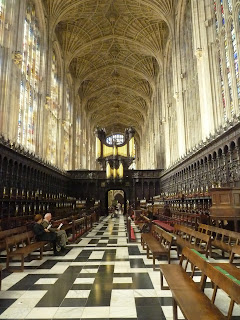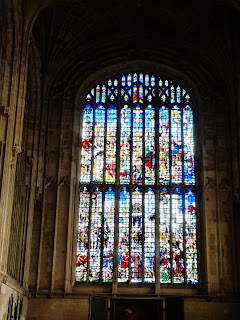I had never considered the importance of churches in the history of England. In the US, churches are one facet of society but government buildings, like the WV State Capitol, monuments like those in Washington, museums and other secular structures are our places of architertural wonder for the most part. In England, I found myself in churches and chapels often, and left each one amazed at the quality of work achieved by people working only with hand tools so many centuries ago. It truly boggles the mind.
King's College Chapel is a good example of such workmanship. Begun in 1446 and not completed until 1536, the construction spanned the reigns of several kings: Henry VI, who conceived the idea and laid the first stone, Edward IV, Richard III, Henry VII, and Henry VIII. (And maybe I missed one or two.)
Trying to take in such a structure is really overwhelming. What to notice first? The high, vaulted and intricately detailed ceiling?
The huge stained glass windows? The rood screen? The tombs? The pipe organ? How to take it all in, and how to photograph such a massive space?
The windows drew me to them; a lover of glass, particularly colored and stained glass, they caught my eye immediately. I wondered, how did these huge panels survive the bombings during World War II? Surely they would have shattered. I later learned that the windows were removed and stored for safety. What foresight! The delicate shading of faces and clothing is remarkable, particularly when considering that this art was created in the 1500's.
The rood screen, intricate and delicate woodwork that separates the nave from the altar, defies description. (Forgive my poor photo. For a better look at the screen, go here) The screen was built by Henry VIII after his marriage to Anne Boleyn.
My cousin John pointed out the initials "H" and "A" in several places in the design, which struck me as the fancy of almost school-infatuation--how many young men carve their intials with their true loves into a tree? This carving, however, was meant to last for centuries, and it certainly far outlasted the romance of Henry and Anne. I wonder, what did his subsequent wives make of it?
The Chapel houses an unexpected treasure: a painting of the Adoration of the Magi by Rubens.
The exterior of King's College and the chapel is as grand and awe-inspiring as the interior. A variation on the colors of the stone are indications of times when work stopped and then began again, sometimes with stone from a different area of the country. There were many such interruptions, as kings were deposed, executed or died (did any of them die naturally? Brit historians, do you know? In my readings it appeared that unnatural death was more common than not for rulers in those times.)
Here are a few photos of the exterior and grounds:
Copyright Susanna Holstein. All rights reserved. No Republication or Redistribution Allowed without attribution to Susanna Holstein.








King's College Chapel was worth a visit wasn't it? King Edward IV and Henry VII and VIII all died in their own beds but none of them had particularly pleasant deaths. Richard III is the king who was killed at the Battle of Bosworth Field and whose skeleton has recently been discovered in Leicester. His burial place was unknown up to that point. He will be reburied with some pomp and circumstance when they've decided whether his tomb should be in Leicester or York. Both want him but his associations are strongest with York which would be my choice.
ReplyDeleteWow! Such beauty. I always love to visit churches, the world over.
ReplyDeleteI am loving reading about your tip. Thank you for taking the time to sort it all out. It seems a monumental job. I've heard from a tour guide that at least Winchester Cathedral was spared bombing under Hitler's orders, as he planned to be crowned there. --Jane
ReplyDelete